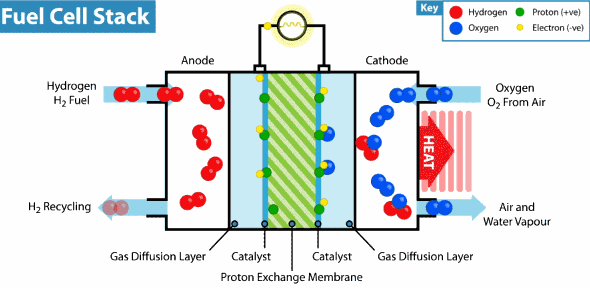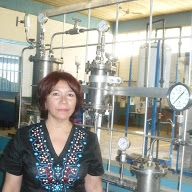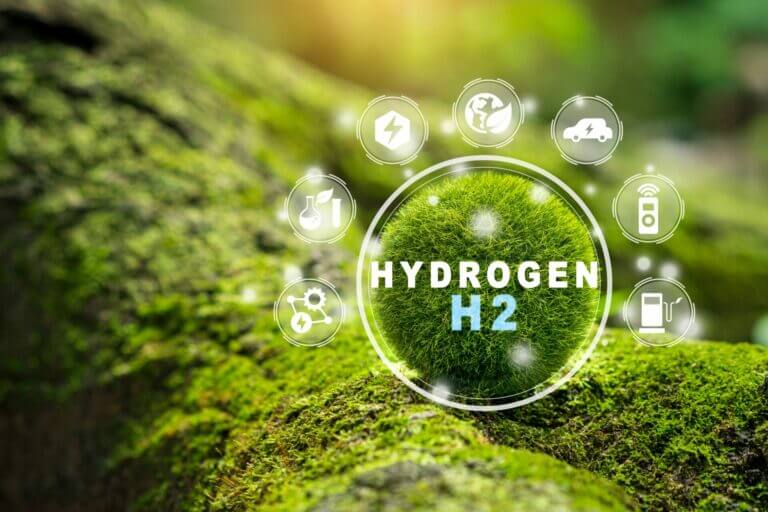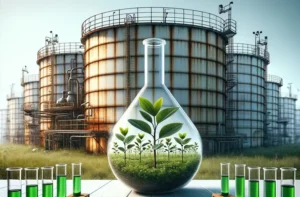Author. Ph.D. Yolanda Reyes, November 28, 2022.
Introduction
Hydrogen is the cleanest fuel there is: it is versatile and extremely efficient, a revolutionary fuel and not only in a technical sense. It will transform social relations throughout the planet.
If the energy future is hydrogen; this will depend on being able to obtain this element and for this you need energy; which can be obtained through renewable energy generators, the possibility is to combine it with solar energy to produce the necessary energy. This means obtaining hydrogen from the sun, that is, a clean source that generates a clean fuel [1].
Sectors such as the steel industry, aviation and long-distance maritime and land transport (trucks and railways) will benefit from green hydrogen, whose advantage is that it burns cleanly, since it only leaves water vapour.
One of the big problems with hydrogen is that currently 96% of it is generated from fossil hydrocarbons, through natural gas reforming, because the production cost is 4 to 10 times cheaper than generating it through water electrolysis ($1.5/kg vs $6-15/kg, respectively). Furthermore, producing a net kilogram of hydrogen by reforming natural gas produces twelve times more CO 2 than electrolysis with wind-generated electricity (11.89 vs. 0.97 kg CO 2 eq/ kg H 2 ). All this without counting that the production of hydrogen is about three times less energy efficient than the use of electricity stored directly in batteries. However, it is possible that in the long term the efficiency and cost of electrolysis will improve and it may make sense from an economic and energy point of view, even as a means to store surplus energy from renewables [2].
The result is that the current model of hydrogen production will imperish the polluting and centralized system of generation and distribution dependent on oil companies. Green hydrogen, on the other hand, is produced by electrolysis, using an electric current to separate hydrogen from oxygen in water. If this electrical current is generated from a renewable source (solar, wind or hydroelectric power), the clean hydrogen produced is known as green hydrogen. This process does not generate emissions.
Fossil fuels or hydrogen
Just as the industrial revolution occurred during the 19th century and was based on the use of coal as an energy resource, it can also be said that during the 20th century and up to the present we live in the oil age. XXI the age of hydrogen?
The 20th century belonged to oil, food, clothing, pharmaceuticals, plastics, construction materials, energy, all of this is made or derived from oil.
It is necessary to clarify that hydrogen, unlike coal and oil, is not a natural resource, it is not a resource that can be obtained from nature by mining or extraction tasks, as is the case with fossil resources in general.
For centuries and throughout history, wood, coal, oil and natural gas have been incinerated, however, what is actually burned is the hydrogen contained in these materials; that is, what is not burned ends up in the air in the form of carbon, which is pollution, so it is concluded that the ideal is to burn pure hydrogen. Throughout history the transition has occurred to burn less carbon and more hydrogen, so the next logical step is to start burning pure hydrogen.
In this context, hydrogen is valuable in part because of its versatility. It can be burned as a substitute for fossil fuels such as coal, oil, and natural gas. All of these fuels produce carbon dioxide when burned, while burning pure hydrogen in a turbine produces only water vapour. However, it also catalyzes the production of harmful nitrogen oxides due to the high temperatures involved. Another way to use hydrogen is in fuel cells (Figure 1), which combine hydrogen with oxygen to create water and electricity, the opposite of electrolysis[3].

Hydrogen is an energy carrier, just like electricity it is necessary to obtain it from other raw materials (water, biomass, fossil resources) and to convert these materials into hydrogen it is necessary to follow some transformations in which some source of energy is consumed. primary energy (nuclear, renewable or fossil). Hydrogen is currently used in many industrial processes; therefore, it could be said that hydrogen is an old acquaintance in the industry, however, its role has been that of one more component of those involved in these processes. On the contrary, what is emerging at the present time is the use of hydrogen as a new energy vector that allows development compatible with respect for the environment.
In the evolution towards a future energy scenario in which hydrogen becomes important as an energy option, it is possible to imagine that the other available resources, whether fossil or nuclear, will continue to be used, however, for the first time in history, a system will be established of energy based on inexhaustible natural resources on the one hand and on the other with a more egalitarian distribution throughout the world than fossil fuels have today.
In several aspects, hydrogen is a safer fuel than gasoline, although we must consider that any fuel with a high energy content is a danger in itself, but if there is an accident and the tank where it is stores hydrogen breaks, hydrogen being lighter than air would escape directly into the atmosphere away from its occupants, something that would not happen with gasoline, it would spill and if there is ignition it envelops the vehicle in flames. Gasoline is flammable, gas is flammable and yet we use them, they are combustible and they burn, that is what they are supposed to do, so hydrogen is not very different in that aspect from the other fuels that we use today .
Green hydrogen processing from water electrolysis
Currently hydrogen is produced from fossil fuels (hydrocarbons such as natural gas and coal). As a consequence, hydrogen production is responsible for the emission of around 830 million tonnes of carbon dioxide per year, equivalent to the CO 2 emissions of the UK and France combined.
Most of the manufactured hydrogen is obtained by combining natural gas with steam at high temperatures. It is a process that consumes a lot of energy and emits considerable amounts of carbon dioxide, the main greenhouse gas that drives climate change. But a small and growing percentage is made by splitting water into its constituent elements using electricity, a process known as electrolysis.
On the other hand, hydrogen offers an attractive energy carrier in the long term, through a non-polluting alternative, the so-called green hydrogen. It involves taking water from nature and separating it into its parts (hydrogen and oxygen) using renewable electricity, storing hydrogen, transporting it, distributing it and, finally, using it following conventional thermal processes (internal combustion engines or jet fuel) or electrochemical processes. such as fuel cells, returning to nature the same amount of water that we had previously obtained from it (Figure 2). In the thermal conversion of hydrogen, hydrogen oxides would be emitted, although in a lower proportion than those emitted with fossil fuels, while in the use of fuel cells, the emissions of pollutants into the environment would be zero.

Figure 2. Obtaining green Hydrogen by electrolysis of water, Courtesy of Mackenzie.
There is only one drawback to hydrogen, unlike other materials, hydrogen is not found in deposits, it is found in wood, coal, oil and gas, but above all it is found in water, that is, the best way to extracting hydrogen is from water, there is a lot of water, but… How to extract hydrogen from water?
If an electric current is applied to water, it separates into hydrogen and oxygen, these are gases and these can be stored, and you can reverse the process, mixing oxygen and hydrogen in a fuel cell you get water and electricity; but, although it sounds extremely simple, there is a redundancy, to extract the hydrogen you still need electricity.
With renewable energies, water and using hydrogen and electricity as energy vectors, it will be possible to meet all energy needs with practically zero emission of pollutants. If such a scenario is implemented, then it could be said that the revolution of the hydrogen and we would have entered the age of hydrogen.
the twilight of oil
Although different studies give different results about the available reserves and their duration, the depletion of fossil fuels is a fact and while scientists try to discover ways to effectively control the fusion energy production process, it is necessary to carry out humanity towards a safer, more durable and non-polluting form of energy. Hydrogen together with renewable electricity as energy carriers offers this possibility.
Very soon there will be no oil, the good thing is that a new source of energy is on the doorstep, which is hydrogen, some trend analysts, car manufacturers and some world politicians declare that the end of the oil era is near and they speak of hydrogen as the main candidate for the future.
The hydrogen economy
The primary objective of hydrogen must be the equal distribution of energy throughout the world, each and every one of the planet’s inhabitants should have access to energy thanks to renewable energies and hydrogen, that is, if the most poor cease to depend on oil, hydrogen could liberate the third world from its position of dependence forever.
It can be said that there have been three industrial revolutions, the first industrial revolution occurred with the union of the printing press with the steam engine and the railway, whose multiplier effect materialized in the 19th century, the second occurred with the union of the telegraph telephone and electricity with oil and internal combustion engine. The third industrial revolution will have an impact as great as the other two and will come with the union of two factors, the decentralization of communications and the ability to share energy equitably throughout the world, a decentralized distribution of hydrogen.
The technology is not fully developed, it is expensive, there are many companies and commercial protagonists that will try to stop it, political interests at stake, it is very complicated to generate an infrastructure, etc…, when the energy regime changes, the most disturbing revolutions in history take place, they alter technologies, infrastructures, politics and trade, but there is nothing new in that, revolutions and similar changes have already passed through the first and second industrial revolutions, so we will advance from fossil fuels to hydrogen, it will be very difficult, it is not a luxury or a whim, it is about survival and adaptation, about the future we want for future generations and how we want to spend our money, that must be our legacy and heritage, open ourselves to new things that give possibilities for future generations.
Conclusion
Green hydrogen is the fuel of the future. The ability to use a fuel with a zero CO 2 footprint represents a revolution in the energy and transport sector. Gasoline, gas, coal and all other fuels will be gradually displaced by hydrogen. From industrial to domestic use, the way forward is the use of hydrogen as the main fuel. In addition, as already mentioned, ultimately it will be the regulating element of the balance of the electricity market.
References
[one]. Hortal, Mario Aguer; Barrera, Angel Luis Miranda (January 12, 2012). Hydrogen: Foundation of a balanced future. Diaz de Santos Editions. ISBN 9788499690780. Accessed December 2, 2017.
[2 ] https://www.hydrogen.energy.gov/pdfs/2013_htac_annual_report.pdf
[3] Ulises Cano Castillo. Fuel cells: truths about the generation of clean and efficient electricity via electrochemistry.

About the Author. Yolanda C. Reyes, Chemical Engineer. M.Sc. In Chemical Engineering, PhD. Electrochemistry and Corrosion, 30 years of university academic experience in teaching and research and technical as a consultant in corrosion in the oil and gas industry. Advisor of maintenance program plans in the oil industry, in charge of service works in chemical and mechanical cleaning of equipment such as: Boilers, Heat Exchangers or similar, with knowledge, handling and application of chemicals for Chemical cleaning.


























